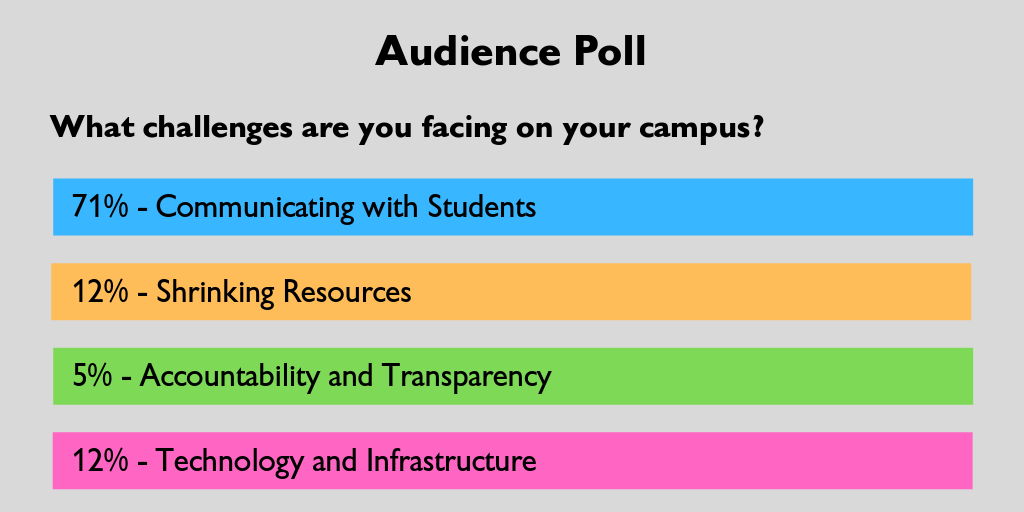The Benefits of Going Mobile: An Interview
By: Annie on Oct 22, 2018 1:44:00 AMThe Benefits of Going Mobile: An Interview
By: Annie on Oct 22, 2018 1:44:00 AM
In a recent webinar, we interviewed Cloud County Community College’s Marc Malone (Associate VP of Planning and Assessment) and Southern Maine Community College’s Jason Saucier (Director of Campus Life) to find out how they are leveraging their campus app to unify communication, track data, and assist with outreach.
.png)
Question: What were some of the biggest challenges that your campuses were facing prior to adopting the app?
Marc Malone: Before adopting the app, Cloud was seeing declining enrollment (persistence, retention), and declining financial resources (enrollment, state funding). We also had trouble communicating with students (billing, meeting and event attendance, clubs/groups), student engagement, and self-efficacy.
Jason Saucier: Three of the main challenges we were looking to overcome were declining enrollment, lack of effective communication with students, and low student engagement.
Q: Jason, can you give us an example of this?
J: The campus email is the official communication channel; however, it is not uncommon that students miss important emails. We had a bumpy starts to our fall this year when we had to close one of our residence halls a week before opening due to some facilities issues, so we had to put 300 students into hotels. We had planned a day to move these students back to campus; we sent email after email, we put flyers under their doors, we had flyers in the hotel lobby, and we still found students posting on the app “when is moving day?” Thankfully at that point we already had the app and were able to post all the relevant information on the campus wall.
Q: How did you justify the purchasing of a campus app?
M: In September 2017 we had an strategic planning meeting where admins across campus were given an avenue to express their opinions. One of the main issues that we decided we wanted to focus our attention on was increasing student engagement, which included increasing participation in events, clubs, organizations, and co-curricular events.

Q: How did you gain meaningful adoption of the app?
M: Tying the app to a larger project was key in promoting adoption. Once everyone was aligned in that we wanted to increase student engagement on campus as part of our strategic plan, and that the app was going to be the avenue to do so, it became easy to promote. It also made it easier for us to prioritize financial resources to fund it, since multiple departments would benefit from the app.
J: We see half of all downloads and registrations happen during the summer months, from May to late August. We market the app on our webpage, student portal, all of the welcome-week material that gets sent out to students, and our summer registration meetings that happen throughout the summer. I think this is because students look to make connections before they arrive on campus. Also if they have questions, they turn to the campus wall.
Q: How are on-campus departments using the app to engage with students?
M: Many of our departments are leveraging the app to engage and communicate with students. For example, the tutoring center uses the app to communicate things on short notice like “hey, the math instructor has stopped by and he’s going to be here for two hours” or “we have a special study night for algebra midterms.” They are also using it to track engagement. When students come in, they have to check-in, which allows us to collect data on whether the student is coming in for testing, quiet study time, or meeting with a tutor. Each individual tutor has their own QR code which allows us to see which tutor has the best rating, as well as gather student feedback. This is really valuable for administrators because it allows us to see how we can improve this service, and allows tutors to discover what students are finding particularly helpful.
J: Every week we assign someone from our 4 person team to monitor the app and engage with students. We have a schedule where we decide what we want to promote during which time throughout the year. Trying to be mindful that it isn’t staff-heavy, because it is a place for students, but it’s been helpful for our staff to include talking points on the app.
Community College Facts
- The overall three-year completion rate for community college students nationwide was 24% for the 2000 cohort and 20% for the 2010 cohort.
- Low-income students are overrepresented in community colleges
- Community colleges are given comparatively few resources
Generation-Z Facts
- Generation of “access”
- 97% smartphone penetration among 18-24 year olds
- Average daily time on mobile: 4.2 hrs
- Mobile accounts for 52% of time spent online
- 61% would prefer to be entrepreneurs rather than employees after college
- Willing to provide feedback – they will tell you when something isn’t working
We’d like to thank both Marc Malone and Jason Saucier for their time and feedback. If you think your campus might benefit from an app, or if you have any questions, feel free to reach out!

.png)
.png)
.png)

